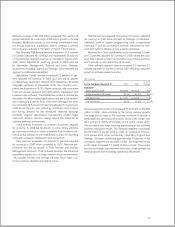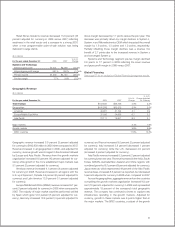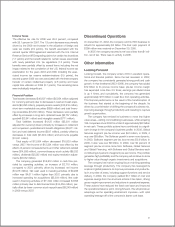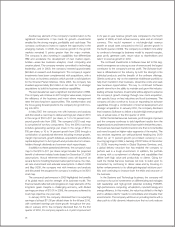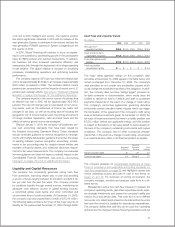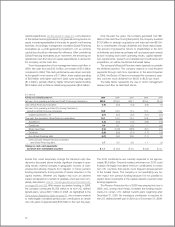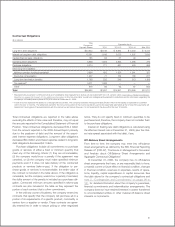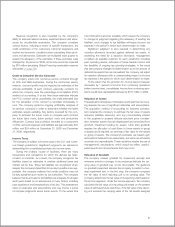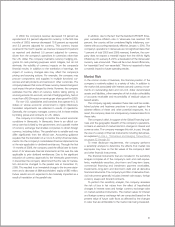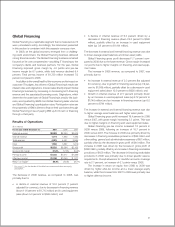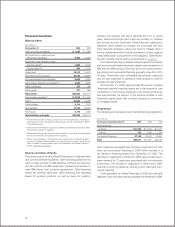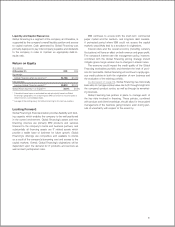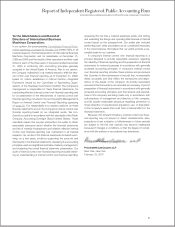IBM 2009 Annual Report Download - page 55
Download and view the complete annual report
Please find page 55 of the 2009 IBM annual report below. You can navigate through the pages in the report by either clicking on the pages listed below, or by using the keyword search tool below to find specific information within the annual report.
Revenue recognition is also impacted by the company’s
ability to estimate sales incentives, expected returns and allow-
ances for uncollectible receivables. The company considers
various factors, including a review of specific transactions, the
credit-worthiness of the customers, historical experience and
market and economic conditions when calculating these provi-
sions and allowances. Estimates are evaluated each quarter to
assess the adequacy of the estimates. If these estimates were
changed by 10 percent in 2009, net income would be impacted
by $74 million (excluding Global Financing receivables reserves
discussed on page 59).
Costs to Complete Service Contracts
The company enters into numerous service contracts through
its GTS and GBS businesses. During the contractual period,
revenue, cost and profits may be impacted by estimates of the
ultimate profitability of each contract, especially contracts for
which the company uses the percentage-of-completion (POC)
method of accounting. If at any time these estimates indicate
the POC contract will be unprofitable, the entire estimated loss
for the remainder of the contract is recorded immediately in
cost. The company performs ongoing profitability analyses of
its services contracts in order to determine whether the latest
estimates require updating. Key factors reviewed by the com-
pany to estimate the future costs to complete each contract
are future labor costs, future product costs and productivity
efficiencies. Contract loss provisions recorded as a component
of other accrued expenses and liabilities are approximately $37
million and $24 million at December 31, 2009 and December
31, 2008, respectively.
Income Taxes
The company is subject to income taxes in the U.S. and numer-
ous foreign jurisdictions. Significant judgments are required in
determining the consolidated provision for income taxes.
During the ordinary course of business, there are many
transactions and calculations for which the ultimate tax deter-
mination is uncertain. As a result, the company recognizes tax
liabilities based on estimates of whether additional taxes and
interest will be due. These tax liabilities are recognized when,
despite the company’s belief that its tax return positions are sup-
portable, the company believes that certain positions may not
be fully sustained upon review by tax authorities. The company
believes that its accruals for tax liabilities are adequate for all open
audit years based on its assessment of many factors including
past experience and interpretations of tax law. This assessment
relies on estimates and assumptions and may involve a series
of complex judgments about future events. To the extent that
new information becomes available which causes the company
to change its judgment regarding the adequacy of existing tax
liabilities, such changes to tax liabilities will impact income tax
expense in the period in which such determination is made.
Significant judgment is also required in determining any
valuation allowance recorded against deferred tax assets. In
assessing the need for a valuation allowance, management
considers all available evidence for each jurisdiction including
past operating results, estimates of future taxable income and
the feasibility of ongoing tax planning strategies. In the event
that the company changes its determination as to the amount of
deferred tax assets that can be realized, the company will adjust
its valuation allowance with a corresponding impact to income
tax expense in the period in which such determination is made.
To the extent that the provision for income taxes increases/
decreases by 1 percent of income from continuing operations
before income taxes, consolidated income from continuing oper-
ations would have decreased/improved by $181 million in 2009.
Valuation of Assets
The application of business combination and impairment account-
ing requires the use of significant estimates and assumptions.
The acquisition method of accounting for business combina-
tions requires the company to estimate the fair value of assets
acquired, liabilities assumed, and any noncontrolling interest
in the acquiree to properly allocate purchase price consider-
ation between assets that are depreciated and amortized from
goodwill. Impairment testing for assets, other than goodwill,
requires the allocation of cash flows to those assets or group
of assets and if required, an estimate of fair value for the assets
or group of assets. The company’s estimates are based upon
assumptions believed to be reasonable, but which are inherently
uncertain and unpredictable. These valuations require the use of
management’s assumptions, which would not reflect unantici-
pated events and circumstances that may occur.
Valuation of Goodwill
The company reviews goodwill for impairment annually and
whenever events or changes in circumstances indicate the car-
rying value of goodwill may not be recoverable. The guidance
on goodwill impairment requires the company to perform a two-
step impairment test. In the first step, the company compares
the fair value of each reporting unit to its carrying value. The
company determines the fair value of its reporting units based on
the income approach. Under the income approach, the company
calculates the fair value of a reporting unit based on the present
value of estimated future cash flows. If the fair value of the report-
ing unit exceeds the carrying value of the net assets assigned
53


